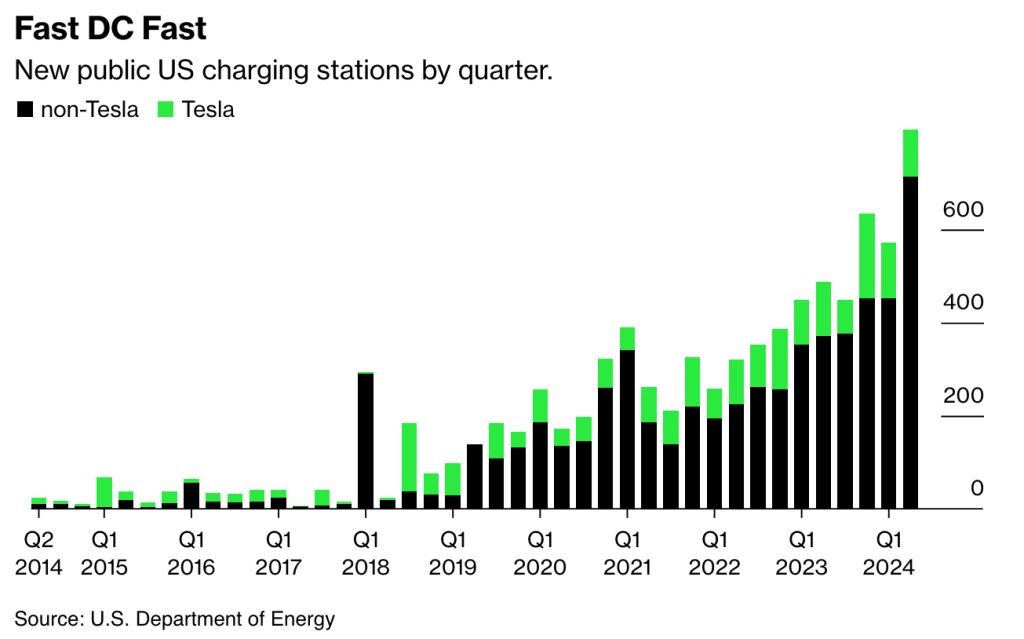- 🌍 U.S. public EV charging stations could outnumber gas stations by 2032.
- ⚡ Fast-charging deployment is accelerating this year.
- 💰 North American spending on charging infrastructure is around $6.1 billion this year.
- 🚗 704 new fast-charging stations added recently in the U.S.
- ⛽ Gas station operators are installing more EV charging stations.
- 🔌 Tesla leads in fast-charging hardware deployment in the U.S.
- 🚘 Only Ford and Rivian EVs currently have access to Tesla Superchargers.
- 📊 EV adoption rate in the U.S. could reach 50% by 2030 despite recent slowdown.
The race toward sustainable transportation has reached a pivotal moment. According to a recent Bloomberg analysis, U.S. public electric vehicle (EV) charging stations are projected to outnumber gas stations by 2032. This remarkable forecast underscores an accelerating shift toward electric mobility, fueled by substantial investments and cutting-edge innovations. In this comprehensive blog post, we will explore the data driving this change, examine the key players in the EV charging landscape, and discuss the broader implications for the future of transportation.
The push toward electric vehicles is not only gaining momentum but is also redefining the American transportation landscape. With fast-charging deployment accelerating and significant investment in charging infrastructure, the future seems unmistakably electric. Let’s dive into the compelling evidence suggesting that public EV charging stations will eclipse the number of gas stations in the United States by 2032.


Analysis of Current Trends
Accelerating Fast-Charging Deployment
Fast-charging stations are being deployed at an unprecedented rate. According to Bloomberg Green, the U.S. has seen a 9% increase in public fast-charging stations in just three months, bringing the total to about 9,000 stations nationwide. This rapid growth is indicative of rising demand and an encouraging shift toward EV adoption.
Substantial Investment in Infrastructure
North American operators are projected to spend around $6.1 billion on charging infrastructure this year, almost double the investment in 2023. This exponential growth in funding underscores the importance that stakeholders place on building a robust and accessible charging network.
Gas Stations Joining the EV Bandwagon
Interestingly, traditional gas station operators are increasingly installing EV charging units. Shell has introduced 30 new charging stations in Q2 alone, while other fuel giants like Enel, Pilot, and Flying J are not far behind. This pivot highlights the recognition of EVs as a critical component of the future energy ecosystem.
The Role of Key Players
Tesla’s Leadership in Fast-Charging
Tesla continues to dominate the fast-charging space with its extensive Supercharger network. Currently, the company has around 2,319 Supercharger stalls in the U.S., providing a significant portion of the nation’s fast-charging infrastructure. However, access to these Superchargers is currently limited to Ford and Rivian vehicles, although Tesla plans to open the network to more EV brands aligned with the North American Charging Standard (NACS).
Broader Implications for the Industry
This rapid growth in EV infrastructure is expected to alleviate one of the primary concerns deterring potential EV buyers—range anxiety. As the network expands and becomes more accessible, consumers are likely to feel more confident in making the switch from gasoline-powered vehicles to electric ones.
Future Projections
Potential EV Adoption Rates
Despite recent reports of an EV sales slowdown in the U.S., analyses from Bloomberg suggest that this may be an overstatement. A study from Recurrent Auto indicates that the U.S. could still be on track to achieve an EV adoption rate of 50% by 2030. This optimistic outlook is bolstered by the rapid deployment of fast-charging stations and increased investment in infrastructure.
Shift in Market Dynamics
The anticipated prevalence of EV charging stations over gas stations will likely lead to several market shifts:
- Reduced Dependence on Fossil Fuels: As more drivers transition to EVs, demand for gasoline will decline, reducing carbon emissions and dependency on fossil fuels.
- Enhanced Energy Sector Opportunities: The rise of EVs opens new avenues for renewable energy integration, creating a more sustainable energy grid.
- Economic Transformation: Investing in EV infrastructure can spur economic growth, creating jobs in technology, construction, and renewable energy sectors.
Conclusion
The future of transportation is electric, with U.S. public EV charging stations set to outnumber gas stations by 2032. This shift is driven by robust investment, rapid deployment of fast-charging infrastructure, and leadership from key players like Tesla. As we move toward a greener future, the implications for consumers, businesses, and the energy sector are immense. Embracing this change will require continued innovation, collaboration, and commitment to sustainable practices.
Stay tuned for more updates as the landscape of electric mobility continues to evolve.





